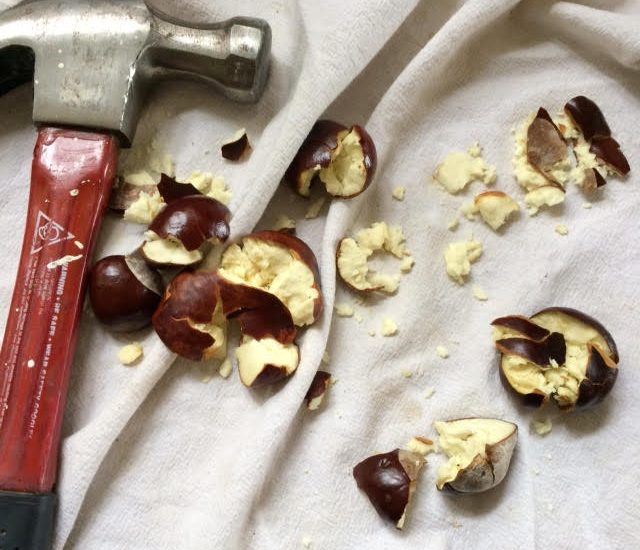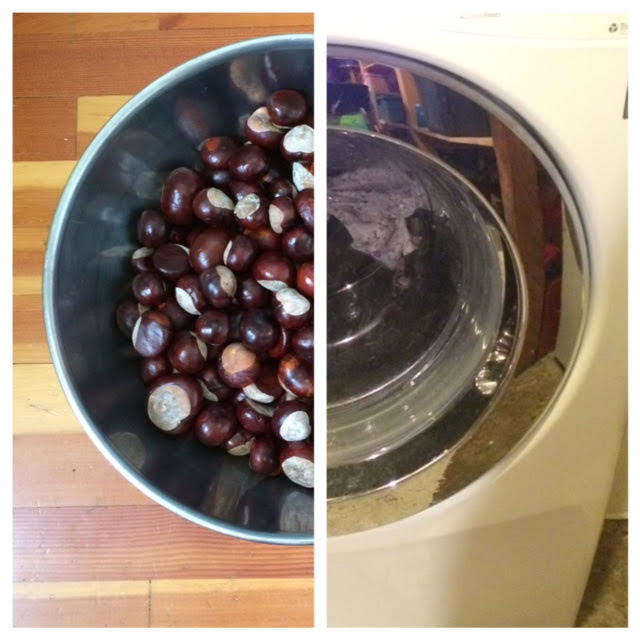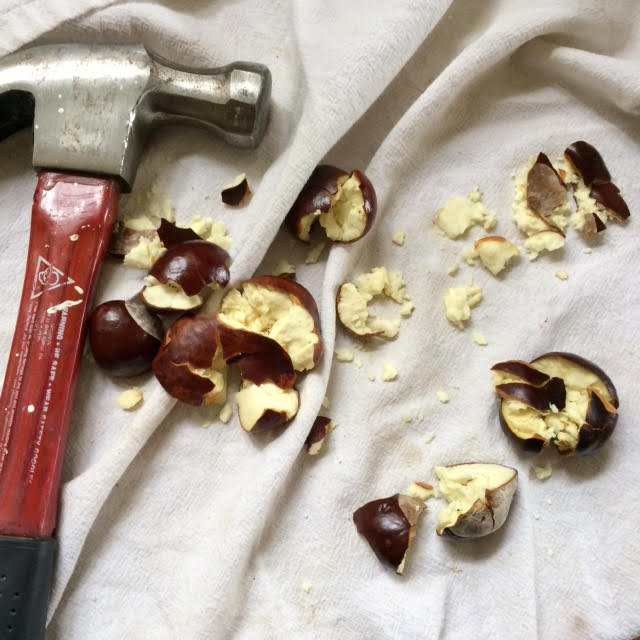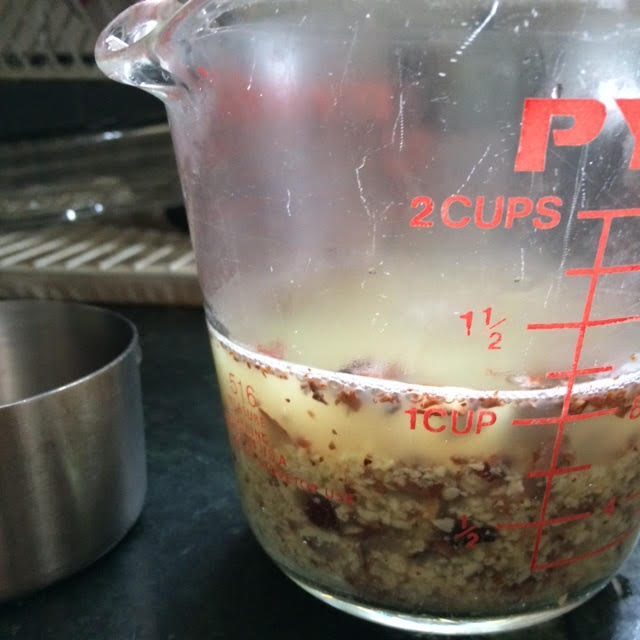While scrolling through Instragram recently, I saw a pic of homemade laundry soap made from horse chestnuts at @less_is_more_pdx. I was amazed! I immediately messaged the woman behind the IG account—Angela Zahas—and asked her if she would like to write a guest blog post about her homemade soap.
Horse chestnut trees grow in temperate areas of North America, Europe and Asia. Early fall is the time to forage for chestnuts—National Chestnut Week in the US runs October 9th–15th (yes, that’s a thing).
Chestnut Soap
by Angela Zahas
We ride past four horse chestnut trees on our bike ride to our 2-year old and 4-year old’s school each day—crushing the nuts under our bike trailer wheels and enjoying the thrill of watching a seed pod fall and crack on the sidewalk, littering the road and walk ways. And they really do make a mess. I know horse chestnuts are not edible and I was curious if there was any practical use for them. Imagine my excitement in seeing a post a few weeks later on @_wastelandrebel_’s Instagram about making chestnut soap. Was it possible to actually make soap from chestnuts? And would it actually clean clothes? I wanted to find out.
The next day, with a bucket in the back of our bike trailer, I set out to gather the abandoned chestnuts.
With the help (but mostly distraction) of the kids, we gathered about 10 pounds and took them home.
Unsure of the best way to crack and grate the nuts into smaller pieces, I gathered a few tools; a kitchen knife, a cutting board, a hammer, a tea towel, a blender (not a high-speed model), and a few measuring cups.
After a bit of trial and error, I found the best method involved placing a nut under a tea towel and hitting it hard with a hammer to crush it and break it into a few smaller pieces. After a few crushes, I found my rhythm and breaking them one-by-one did not take long.
Once I had a couple handfuls of crushed nuts (about 8–10), I put them in my blender and pulsed until they were grated into small pieces, like a pulp.
I took the small bits of chestnuts (about 1/2 cup), dumped them into a Pyrex measuring cup and added 1 cup of hot water.
I let the mixture steep for about 30 minutes. Steeping time will depend on the size of the pieces. Chestnuts just cut into quarters will need to steep overnight, while the pulverized chestnut pulp need only steep 15–30 minutes to release the saponins.
Next, I strained the mixture. It will be just like milk, as thick as whole milk or cream, with a cloudy, yellow color. About 1/4 to 1/3 cup is all that is needed per wash. The liquid detergent can be kept in the fridge for a week.
Chestnuts can be pulverized using the methods above, dried (either in oven on trays over a low temp or in sun) and stored in jars for future use. When ready to make a new batch, take 1/2 cup of dried horse chestnut pulp, soak in 1 cup of boiling water, steep, strain, and use for your next load of laundry.
Alternately, I read that one could put the grated chestnuts or quartered chestnuts in a mesh bag and place directly into the washing-machine, but I haven’t tried that method. Also, some folks peel the skin off the chestnuts for fear the dark skin will stain light-colored clothing. I have not found this to be the case, and my white clothes have not become stained or discolored by the soap.
A word of caution, this soap is gentle and great for delicates and for everyday washing. However, it is not a power stain-fighter. If clothing has a grease stain or another tough stain, pre-treat before washing. Chestnut soap is not equipped to tackle stains that need some extra attention.
Both my husband and I have used the soap on our clothing. The clothes come out smelling fresh and fragrance-free. On our next batch, I will likely add a few drops of essential oils. I am still in awe of the fact that I made soap from a nut that falls in abundance in my neighborhood. It is truly a gift from mother nature.
Angela Zahas lives in Portland, Oregon with her two kids (2 & 4) and husband. She is a mostly zero-waste, bike-commuting, working mom who loves a simple, plant-based recipe, a great doughnut, a funny movie, and a good cry. A native of the Pacific Northwest, she loves a refreshing walk in any weather. Follow her on Instagram @less_is_more_pdx.
Check out my award-winning cookbook!
- Taste Canada silver for single-subject cookbooks
- Second-place Gourmand cookbook award in the category of food waste
- Shortlisted for an award from the International Association of Culinary Professionals












Wow! Reading this I wondered if Acorns could besimilarly used (they grow where I live) and so I googled and found this site that says they can be! Thanks for starting me on this…
https://survive-prepare.com/2013/01/14/acorns-a-great-resource/
Acorns might not work, since they *are* edible, just full of tannins that need to be leached before eating. Not sure if they have saponins. But curious what you find out!
:O Thanks for the info Catherine! That’s so cool. Please let me know how you like your soap. ~ Anne Marie
Wonderful!
I thought so too! I’m so glad Angela shared this info.
what a brilliant idea and thanks for sharing.I didn’t even know you could make soap from conkers!
I was amazed when I saw this too Kathryn. It’s pretty awesome!
Update: I was successfully able to reconstitute the dried chestnut pulp to make liquid chestnut soap. Same process as above. Take 1/2 cup of dried pulp, add 1 cup boiling water, wait 30 minutes, and strain. Should make enough soap for 3 loads of laundry if you use 1/4 to 1/3 cup for each wash.
Thanks so much for the update Angela. ~ Anne Marie
Thank you!!!!!!! I love this. I live in Portland, Oregon where the streets are currently littered with chestnuts. I have been working to decrease/eliminate plastic, and have been struggling with finding household cleaning products to that end. I will be picking up some chestnuts on my walk today!
Wonderful! This is perfect timing 🙂
Wow thanks for sharing!
My pleasure 🙂
Hi,
Never Thought of Chestnut Laundry Soap.
Very interesting.
Thanks
You’re welcome 🙂
[…] always looking for ways to save money, so when I stumbled across this cool tutorial on Zero Waste Chef about using horse chestnuts (or conkers) to make laundry soap I knew I had to give it a […]
[…] always looking for ways to save money, so when I stumbled across this cool tutorial on Zero Waste Chef about using horse chestnuts (or conkers) to make laundry soap I knew I had to give it a […]
I wonder if the soap created from the chestnuts would be gentle enough to wash a human. Can anyone who’s tried it advise.?
I’ve been doing this so this year gathered enough conkers to – hopefully – last me a year. I’d been using soapnuts before, but they needed to be imported so had decided to give conkers a go. Really satisfied with the cleaning power. As a PS, maybe it’s a North America/UK language thing, but we definitely make the distinction between these things – conkers, fruit of the horse chestnut, inedible but contain saponins – and chestnuts – fruit of the sweet chestnut, delicious and nutritious but not a laundry-cleaner! Wouldn’t want anyone either eating the wrong thing or, conversely, trying to make laundry liquid and getting disappointed 😔
Are these horse chestnuts the same thing as buckeyes?
Hi Jaclyn, From what I gather, they are different. However buckeyes contain saponins, which create lather. So I would try this with buckeyes. You could make a small amount and see how it goes. Where I live, we have California Buckeyes. I found this info about those: http://pfaf.org/User/Plant.aspx?LatinName=Aesculus+californica If you try it, will you please let me know how it goes? ~ Anne Marie
Do you think this can be used for hand washing too?
Hi Jesa. I haven’t tried that but from a bit of research, I think it might work. It’s mild. Here’s a thread I found on a permie website I like: https://permies.com/t/2173/horse-chestnut-soap I hope that helps. ~ Anne Marie
Cool post!! Thanks for sharing. Do you know how to store them, if I don’t have the time to chop them up and dried them?
They can be kept in the freezer, but since that isn’t environment friendly, I really hope there is a better option. Please help.
Hi Cheng, If you do have a freezer, I would toss them in there. An empty freezer isn’t any more environmentally friendly than a full one). If you don’t have a freezer, I think you’ll have to chop and dry them. You could do them in small batches if that makes the task easier. Sorry I don’t have a better answer. ~ Anne Marie
[…] always looking for ways to save money, so when I stumbled across this cool tutorial on Zero Waste Chef about using horse chestnuts (or conkers) to make laundry soap I knew I had to give it a […]
[…] always looking for ways to save money, so when I stumbled across this cool tutorial on Zero Waste Chef about using horse chestnuts (or conkers) to make laundry soap I knew I had to give it a […]
[…] always looking for ways to save money, so when I stumbled across this cool tutorial on Zero Waste Chef about using horse chestnuts (or conkers) to make laundry soap I knew I had to give it a […]
Chestnut soap is really interesting and useful at the time of laundry and cost saving as well. Thanks for amazing post.
Hi Pooja, Thanks for checking out the post. Reducing waste and saving money go hand in hand 🙂 ~ Anne Marie
[…] Add a small amount of mild soap/detergent into the water. (Castile soap, soapwort, or horse chestnuts) […]
what a brilliant idea and thanks for sharing
Hi there! This doesn’t mention if husks had to be removed and what they looked like when they were inside the husk. I read an article that said horsechestnut is a term that is also commonly used in reference to buckeye as well… thoughts on this subject?
I also read the post you refer to and your post has reassured me aas I was wondering how do best dry and shred the horse chestnuts. im spending today collecting here in italy and cant wait to try it.
Loved your post and I’m even more excited you live in P town. I’m down the road a few hundred miles so maybe there are some of those horse chestnut trees in my town. Do you suppose any old chestnuts would work?
[…] estoy buscando maneras de ahorrar dinero, así que cuando me encontré con este tutorial fresco en Cero Desechos Chef sobre el uso de castañas de Indias (o conkers) para hacer jabón para la ropa que sabía que […]
Nice I was searching for an alternative nuts instead of soap nuts that I can find easy in Germany. Can I use it in dishwasher and use it for cleaning surfaces?
After reading, I feel like taking a new step to use this in my services which is pollution free and organic. thanks for this wonderful information.
Awesome one.
This is very good information, i would like to thanks for this blog.
Laundry Services in Noida
[…] from ivy.” To do this, you simmer the leaves in water and strain. I hope it works well. (Go here for laundry detergent made from horse […]
[…] Horse chestnut Aesculus hippocastanum (nuts) […]
[…] I would like to thank the following individuals for paving the way: Angela Zahas for her wonderful Chestnut Laundry Soap post on Zero Waste Chef’s website, and Shia Su from Wasteland Rebel for her helpful FAQ on horse […]
good chestnut laundry soap given. Thanks for sharing.
[…] Horse Chestnut Liquid Soap– light DIY liquid detergent suitable for surfaces and even laundry which is not too dirty. […]
Thanks For Sharing this information.
Thanks for sharing valuable information.
Hi. Do the horse chestnuts need to be chopped before drying? I’ve just collected loads of horse chestnuts with my kids from my mum’s garden and want to do something useful with them. Thankyou!
Laundry is an essential part of life. Thanks for sharing information about the laundry soap